Sustainability Evaluation of Different Systems for Sea Cucumber (Apostichopus japonicus) Farming Based on Emergy Theory
WANG Guodong, DONG Shuanglin, TIAN Xiangli, GAO Qinfeng, and WANG Fang
?
Sustainability Evaluation of Different Systems for Sea Cucumber () Farming Based on Emergy Theory
WANG Guodong, DONG Shuanglin*, TIAN Xiangli, GAO Qinfeng, and WANG Fang
,,,266003,
Emergy analysis is effective for analyzing ecological economic systems. However, the accuracy of the approach is affected by the diversity of economic level, meteorological and hydrological parameters in different regions. The present study evaluated the economic benefits, environmental impact, and sustainability of indoor, semi-intensive and extensive farming systems of sea cucumber () in the same region. The results showed thatindoor farming system was high in input and output (yield) whereas pond extensive farming system was low in input and output. The output/input ratio of indoor farming system was lower than that of pond extensive farming system, and the output/input ratio of semi-intensive farming system fell in between them. The environmental loading ratio ofextensive farming system was lower than that of indoor farming system. In addition, the emergy yield and emergy exchange ratios, and emergy sustainability and emergy indexes for sustainable development were higher in extensive farming system than those in indoor farming system. These results indicated that the current extensive farming system exerted fewer negative influences on the environment, made more efficient use of available resources, and met more sustainable development requirements than the indoor farming system.farming systems showed more emergy benefits than fish farming systems. The pond farming systems ofexploited more free local environmental resources for production, caused less potential pressure on the local environment, and achieved higher sustainability than indoor farming system.
; farming systems; emergy theory; sustainability
1 Introduction
Sea cucumber is an important mariculture echinoderm species in northeast Asia because of its nutritional and curative properties (Okorie., 2008). Natural resources ofhave declined over the past 20 years because of overexploitation (Conand, 2004).farming has been rapidly developed in recent years because of its high value. In 2010, the farming area ofreached 1.5billionm2and its total production reached 130000 tons, which brought about an annual value of 20 billion Chinese Yuan (CNY) in China (MOAC, 2011).
At present,land-based farming systems include indoor, semi-intensive, and extensive systems. According to Li. (2013a, 2013b), the total organic carbon, total nitrogen, and total phosphorus contents in the outflow water are less than those in the inflow water ofextensive farming system. Therefore, the sea cucumber farming system is not only a production system of aquatic products but also an environment friendly system. To improve the yield of, many farmers adopt semi-intensive or indoor farming systems with artificial diets. As these patterns increase the inputs of supplemental energy and organic matter, the sustainability of such farming systems has attracted public attention (Ren., 2012a, 2012b).farming systems are semi-artificial ecosystems in which both ecological and economic processes play significant roles. Thus, the ecological and economic natures offarming systems are difficult to determine using only a single ecological or economic method.
Using the principles of energy systems theory, Odum (1983) developed a comprehensive ecological economic evaluation method for evaluating different energies, materials, and monetary ?ows in terms of their ‘emergy’. Emergy is defined as an available energy used directly or indirectly to produce a product or service (Odum, 1996). Emergy is usually quanti?ed in solar energy equivalents and expressed as solar emjoules (sej) (Ulgiati and Brown, 2009), a conversion factor (transformity) that reflects the qualitative value of energy. By multiplying their respective transformities, the emergy of each resource, service, and corresponding product can be calculated. The resulting values can then be analyzed easily based on the same dimension.
Following its development and application over the past 30 years, the emergy analysis approach has been proven to be an effective tool for measuring the efficiency and sustainability of a system (Brown and Ulgiati, 2004). Several studies on fish and shrimp farming systems have been reported, including those for(Brown., 1992),(Brown and Bardi, 2001),(Odum, 2001),(Vassallo., 2007),,,,(Li., 2011),,, and(Zhang., 2011). Qin(2009) analyzed the extensive farming system ofusing the emergy approach.
Due to the differences in regional economic development levels, as well as meteorological, hydrological, and other natural conditions, the emergy of a production or service may be entirely different. Comparing the different data of different regions may obtain false or infeasible results without the exact emergy data of the production or service. In the present study, emergy analysis methods were applied to evaluate the indoor, semi-intensive, and extensive farming systems ofin the same region with similar economic development levels and meteorological and hydrological conditions to overcome the interference of inaccurate regional parameters. The systems were objectively evaluated in terms of their resource inputs, productivity, environmental impact, economic benefits and sustainability.
2 Materials and Methods
2.1 Location and Data Collection
In the present study differentfarming systems in Qingdao, China were detected. The region had an average annual solar radiation of 4.8×109Jm?2(Wang., 2010), an average annual rainfall of 750mm (WSP, 2009), an average annual wind speed of 4.5ms?1(Wang, 2007), and an average annual tide range of 3.20m (Hu., 1989; Zhang., 2000) (Table 1).
The indoor farming system studied was a greenhouse wherewere reared in 20 square concrete tanks (approximately 25m2in area, 1m in water depth) in a stocking density of about 1.5kgm?2.were fed twice a day with commercial fermentative feed. Polyethylene corrugated sheets were used as a substrate for. Aeration was provided continuously to maintain adequate dissolved oxygen. Adult(120– 150g) were captured once a year in October with the mortality rate of 20%, and fingerlings were complemented afterward.
The ponds of the semi-intensive farming system were confined mainly to intertidal zone. The water area of each pond was about 40000m2with an average water depth of 1.5m. The ponds relied on the tides as a means of water exchange. Farmers obtained land use rights through a contract with the local government, paying ‘rent’ during the contract. Stones, tiles or polyethylene cages were used as substrates of. The producers of the semi- intensive farming system relied on the tides and sediment accumulation to provide most of the food for, and supplemented nutrition with formulated feed. The stocking density was about 0.054kgm?2. Aeration was used discontinuously to provide adequate oxygen forin the semi-natural farming system. Adult(120–150g) were harvested twice a year, in March and November, with the mortality rate of 10%, and fingerlings were supplemented into the ponds in spring and autumn.
The extensive farming system featured characteristics similar to those of the semi-intensive system but operated without artificial feeding and aerators. The stocking density of this system was about 0.046kgm?2.
During the investigation period in 2012, 3 indoor farming systems (amount to 200 tanks approximately), 4 semi-intensive farming systems and 3 extensive farming systems (amount to 80 ponds approximately) were investigated. All local renewable resource inputs and purchased resource inputs considered in the production systems were provided by farmers working in the three systems, and converted to annual ?ows.
Among the purchased resource inputs, the energy of the fingerlings was measured with a calorimeter (PARR Instrument Company, USA). The emergy of electricity and coal was calculated by multiplication coefficients of 3.6×106J(kWh)?1and 2.3×1010Jt?1(EC, 2007), respectively. Purchased resource inputs, including direct labor, rent, maintenance, pesticide, feed, and capture, were reported in monetary terms (Odum, 1996).
2.2 Methods of Emergy Analysis and Evaluation
Emergy resources included local renewable resource inputs and purchased resource inputs. The former included solar radiation, wind, rain, tides, and sediment accumulation, while the latter comprised fingerlings, electricity, coal, direct labor, rent, maintenance, pesticide, and feed (Table 1). The ‘Maintenance’ included depreciation period of boiler (3 years), substrate (4 years), roof (3 years) and aeration equipment (2 years) in indoor farming system and substrate (4 years), ponds clean (3 years) and aeration equipment (2 years) in semi-intensive and extensive farming systems.
The total emergy () flow offarming system was calculated using the following equation:

whereis local renewable resource input,is the renewable fraction of the purchased resource inputs, andnis the non-renewable fraction of the purchased resource inputs. The emergy yield ratio (), an indicator of the production efficiency of a system or process for exploiting local resources, is calculated as follows (Odum, 1996):
.
The environmental loading ratio (), an index of the potential pressure on the local environment or system stress due to production activity, is calculated as follows (Odum, 1996):
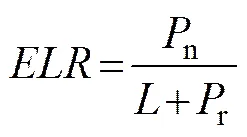
The emergy sustainability index (), a ratio that measures the contribution of a resource or process to the economy per unit of environmental loading, is calculated as follows (Brown and Ulgiati, 1997):
.
The emergy exchange ratio (), an indicator of the emergy benefits or losses from the sale of products, is calculated as follows (Odum, 1996; Lu., 2009):
,
where (income·(sej/CNY)) is the emergy embodied in the received money. The emergy index for sustainable development (), an indicator of the sustainability of the system considering the effects of market exchange on the emergy yield, is calculated as follows (Lu., 2009):

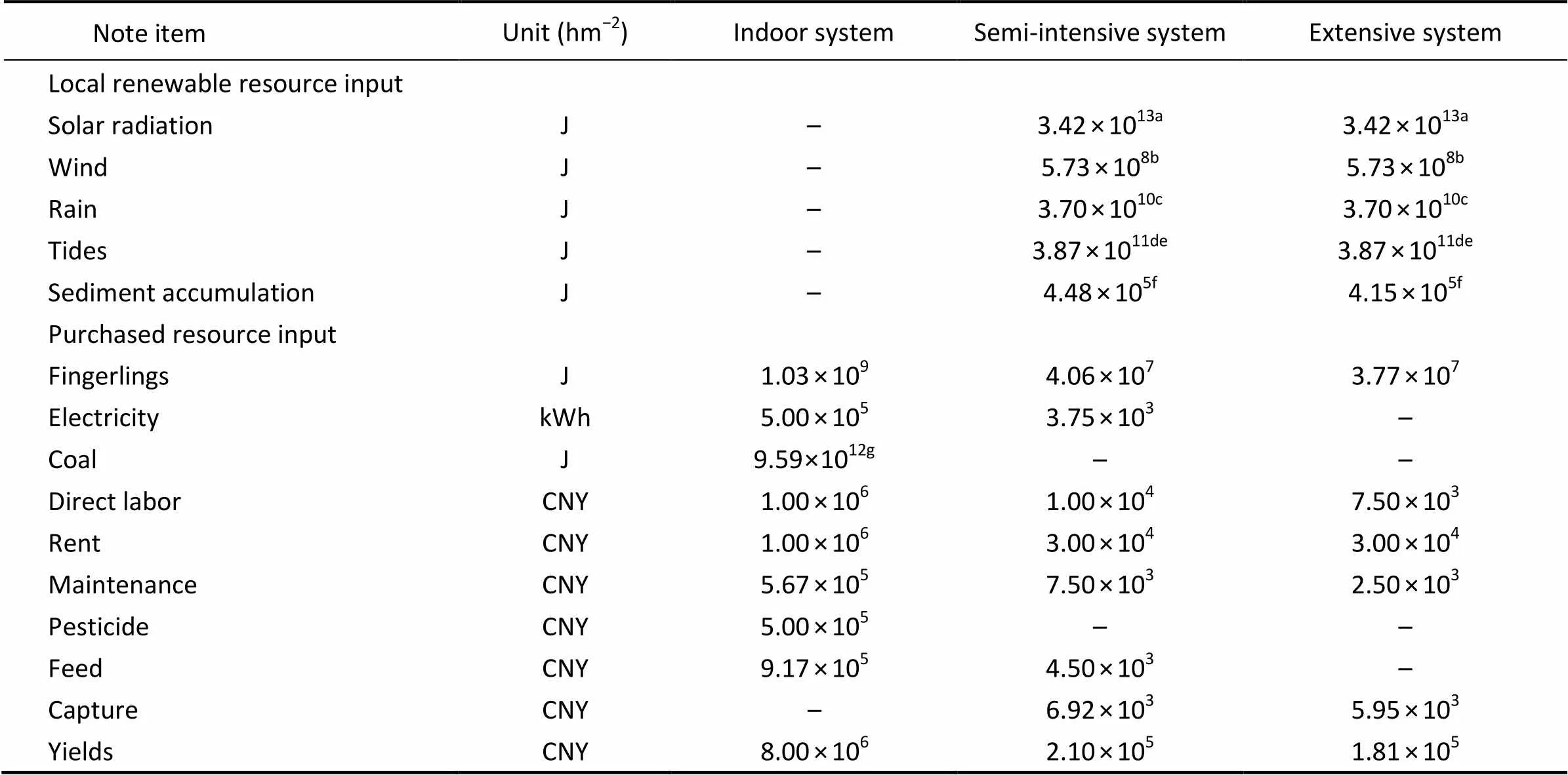
Table 1 Annual emergy accounting and analysis table for the three farming systems of A. japonicus
Notes:a, Wang., 2010;b, Wang, 2007;c, WSP (Weather of Shandong Province), 2009;d, Hu., 1989;e, Zhang., 2000;f, Qin., 2009;g, EC (Energy of Coal), 2007.
3 Results and Discussion
3.1 Emergy Flows inFarming Systems
Aggregated system diagrams of the three farming systems ofwere shown in Figs.1 and 2 according to Odum (1996). The diagrams illustrated the boundaries, main components, interactions, and emergy driving sources for the systems. Pathways indicated casual interactions, showed material cycles or carry information, and were always created with some energy. Energy system diagrams included pathways for all energy inflows that might be stored, or flow out as exports, or be drained away through ‘heat sink’, representing used energy (without available energy to do work). Symbols for sources and components in the energy system diagrams were arranged from left to right in increasing order of transformity (Odum and Peterson, 1996).
No feed, electricity or maintenance costs were noted in the extensive farming system comparing with the semi- intensive farming system. Pesticide and coal were used to maintain the health and fast growth ofin the indoor farming system, but no local renewable resources (., solar radiation, wind, rain and tides) were determined comparing with the semi-intensive and extensive farming systems.
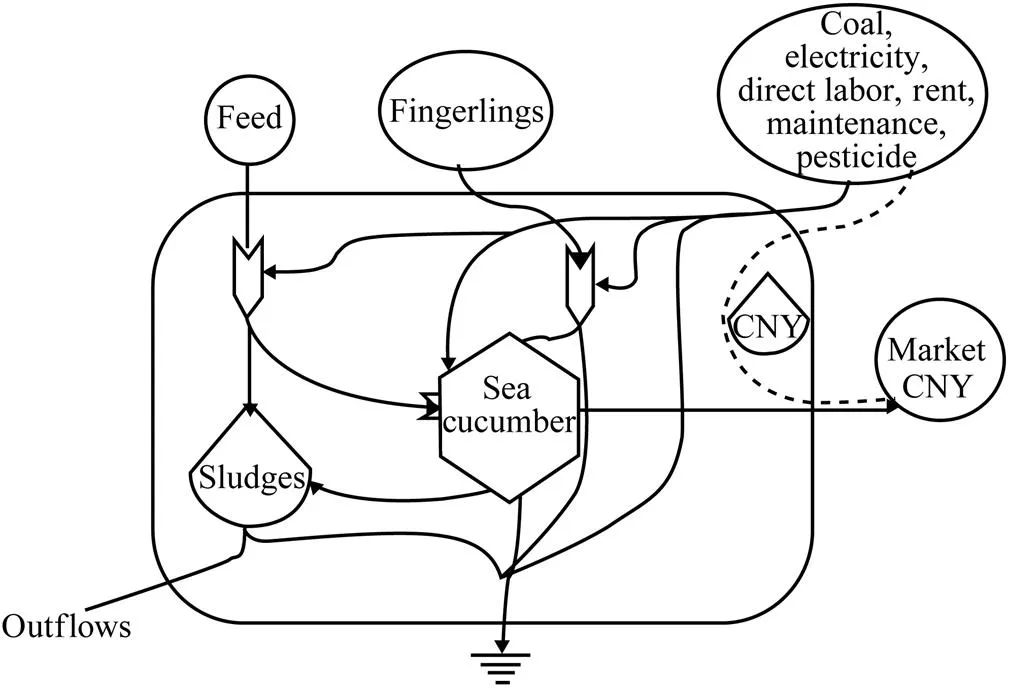
Fig.1 Summary diagram of the emergy flows in the indoor system for A. japonicus farming.

Fig.2Summary diagram of the emergy flows in the semi- intensive system forfarming.
3.2 Economic Accounting and Analysis ofFarming Systems
Annual economic accounting and analysis table for the three farming systems ofwere presented in Table 2. The indoor farming system had a high input (6530000CNY) and high yield (8000000CNY) features, whereas the extensive farming system had a low input (110000CNY) and low output (181000CNY) features. The output/input ratio of the extensive farming system (1.64) was higher than that of the indoor farming system (1.23). The ratio of the semi-intensive farming system (1.61) was between those of the other two systems.
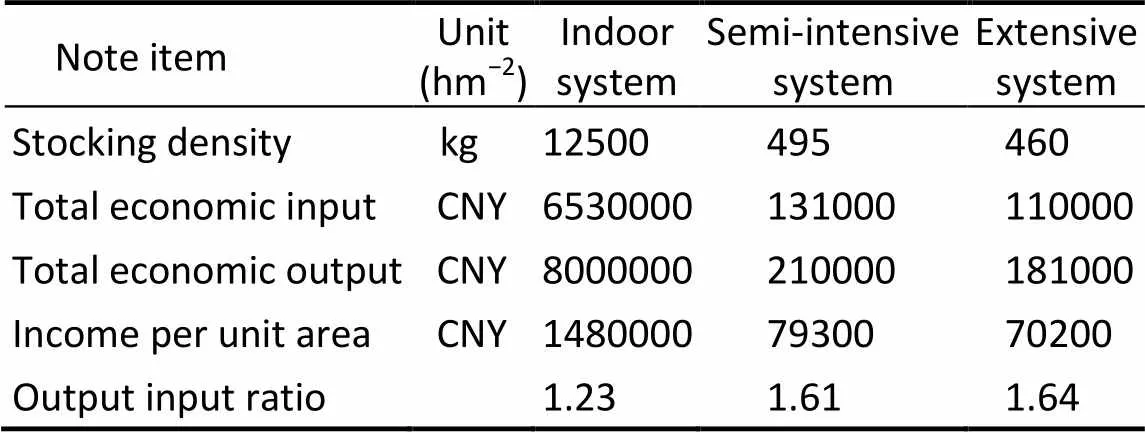
Table 2Annual economic accounting and analysis of three farming systems of A. japonicus
3.3 Emergy Accounting and Analysis ofFarming Systems
Fig.3 shows the main resource inputs for thesefarming systems. The emergy structures (., the types of supporting emergy sources) each production system were detailed in this figure. The total emergy flows of the indoor, semi-intensive and extensive farming systems were 8.32×1018, 1.91×1017and 1.59×1017sej/annual, respectively.
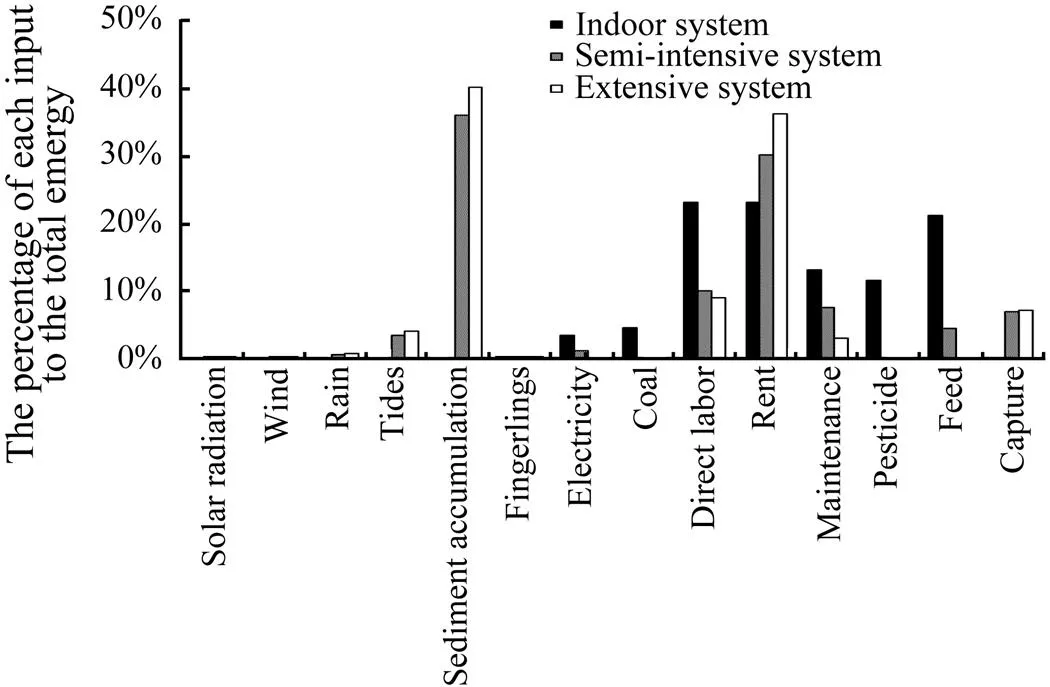
Fig.3Structure of detailed emergy inputs into the three farming systems of.
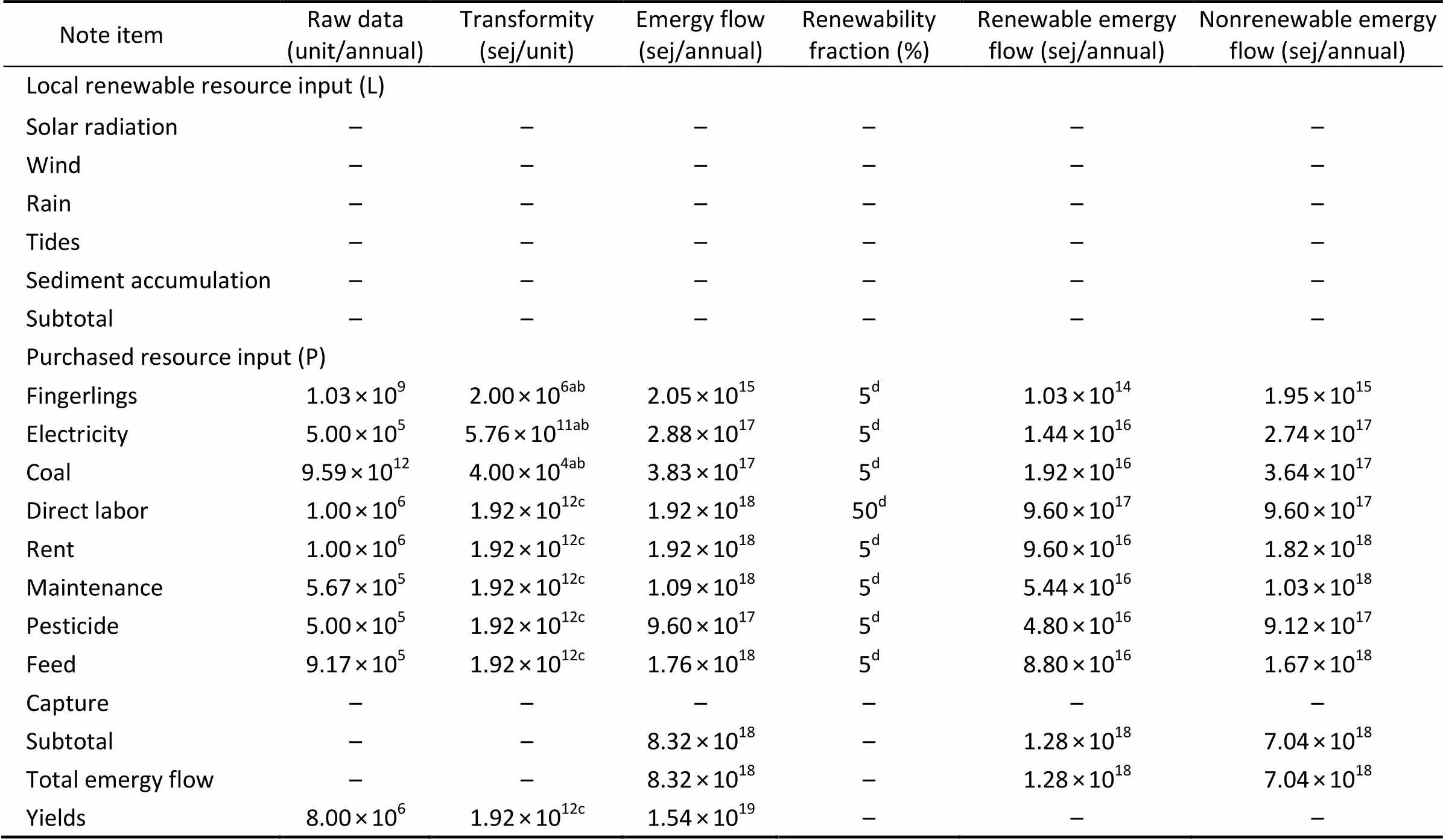
Table 3 Annual emergy accounting and analysis of the indoor farming system of A. japonicus
Notes: The data sources area, Odum, 1988;b, Odum, 1996;c, Jiang., 2008;d, Cavalett., 2006.
As shown in Table 3, in the indoor farming system, the emergies of direct labor, rent and feed showed the same order of magnitude and were higher than those of other purchased resource inputs. To clean the tanks, a large amount of direct labor was needed to movewith substrates from one tank to the neighboring tank every several days. Sediment accumulation was the maximum local renewable resource input in the semi- intensive and extensive farming systems. Rent was the largest purchased emergy input for all the three farming systems (Fig.3).
The renewable and purchased resource inputs in the three systems were multiplied by their corresponding renewability factors in order to divide them into renewable and non-renewable fractions (Zhang., 2011). The results were showed in Tables 3, 4 and 5.
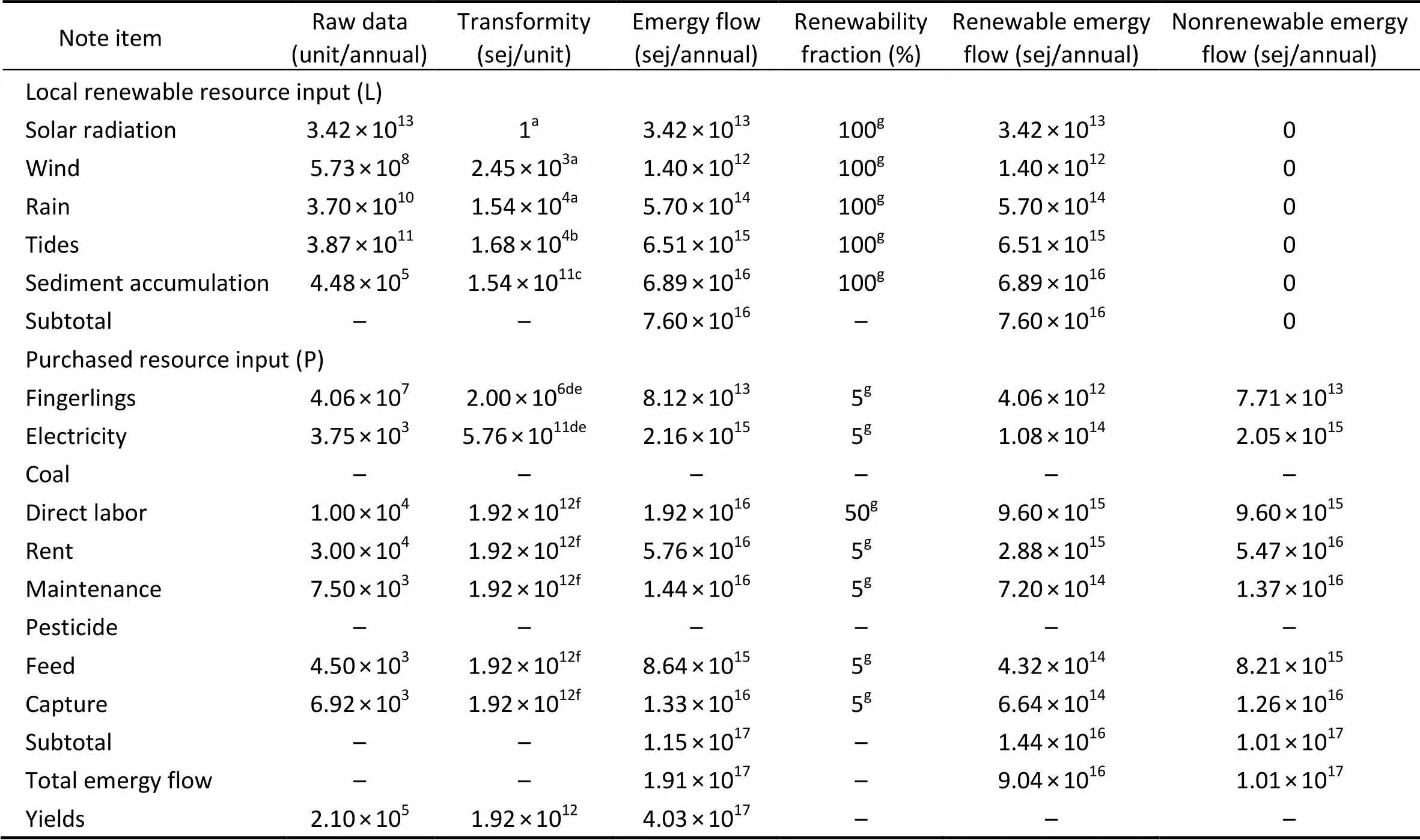
Table 4Annual emergy accounting and analysis of the semi-intensive farming system of A. japonicus
Notes: The data sources area, Odum., 2000;b, Brown and Bardi, 2011;c, Qin., 2009;d, Odum, 1988;e, Odum, 1996;f, Jiang., 2008;g, Cavalett., 2006.
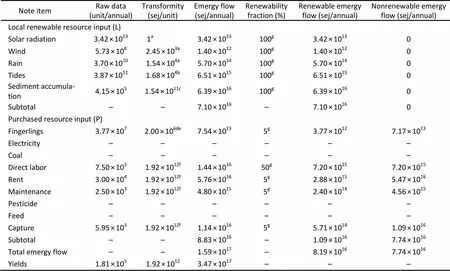
Table 5Annual emergy accounting and analysis of the extensive farming system of A. japonicus
Notes: The data sources are the same as in Table 4.
3.4 Comparison of Emergy and Economic Benefits Among ThreeFarming Systems
The emergy analysis approach was an effective tool for measuring ecological economic systems. However, accurate parameters of economic, meteorological, and hydrological conditions were difficult to obtain. Thus, conducting an ecological economic efficiency analysis among large scale regions was unrealistic. The present study focused on the three farming systems in the same region, Qingdao, to overcome the interference of inaccurate regional parameters. Thus, the systems might be objectively evaluated in terms of their economic benefits, environmental impact, and sustainability.
Comparison and evaluation of emergy and economic indices for the three farming systems were shown in Table 6. The emergy yield ratio () was the ratio of total emergy to the purchased nonrenewable inputs and showed how efficiently the system uses the available local resources (Vassallo., 2007). According to Table 6, the extensive farming system obtained the highest(2.06), followed by the semi-intensive farming system (1.90) and the indoor farming system (1.18). The conversion efficiency of renewable resource decreased with increasing intensification offarming pattern. Theof the indoor farming system was close to 1, which indicates that the system typically exploits few natural resources and relied on the import of high purchased emergy inputs. In a way, the indoor farming system operated more like an industrial process than as a traditional agricultural one, which was characterized by high ecological efficiency (Zhang., 2011).

Table 6Comparison and evaluation of emergy and economic indices for the three farming systems of A. japonicus
If the environmental input ?ows didn’t take economic input flows into account, optimum use of resources could not be achieved, and management decisions would be based on incomplete analyses (Ulgiati., 1994). The emergy exchange ratio () was an indicator and the ratio of emergy exchanged in a trade or purchase (what was received to what was given). The trading partner that received more emergy would receive greater real wealth and greater economic stimulation because of the trade. In the present study the EERs of the indoor system (=1.85), semi-intensive system (2.11), and extensive system (2.17) showed 85%, 111%, and 117% emergy benefits from the market exchange, respectively. The extensive farming system showed more emergy benefit than the indoor and semi-intensive farming systems (Table 6).
Therevealed the pressure on the environment for evaluating environmental services (Vassallo., 2007). ELR was directly related to the fraction of renewable resources, and was considered a measure of ecosystem stress due to production (Ulgiati and Brown, 2009). A largerusually suggested a higher level of environmental stress. Theof the indoor farming system (=5.50) was about five times greater than those of the extensive farming (0.94) and semi-intensive farming (1.12) systems. The results indicated that the pressure exerted by the indoor farming system on local environment was significantly greater than those exerted by the extensive and semi-intensive farming systems.
The emergy sustainability index () was a composite ratio that indicated the process trade-off between the emergy advantage and its environmental pressure (Brown and Ulgiati, 1997; Lu., 2009). In other words, theindicated whether a process or a system provided sustainable contribution to the user with low environmental pressure. Thetook both ecological and economic compatibility into account. A largerusually means a higher sustainability of a process or a system. The order of the ESIs in the present study was as follows: extensive farming system (=2.18)>semi-intensive farming system (1.70)>indoor farming system (0.21). These results indicated that the extensive farming system was relatively sustainable whereas the indoor or industrialized farming system was not sustainable relatively.
After considering the effects of market exchange on output, coupling ofand the emergy index for sustainable development () might be an appropriate approach for measuring sustainability characterized by complex time and spatial scales (Vassallo., 2007). In the present study, the EISDs obtained indicated that the extensive (=4.74) and semi-intensive (3.58) farming systems were more sustainable than the indoor farming system (0.40).
3.5 Comparison BetweenFarming Systems and Other Aquaculture Systems
Previous studies showed that the EERs of,, andrange from 0.46 to 0.52 (Zhang., 2011), and the EERs of,,ranged from 0.61 to 1.48 (Li., 2011). The EERs of the present farming systems were in the range of 1.85–2.17, which indicates that thefarming systems had more emergy benefits than other fish farming systems.
Previous studies showed that the EYRs of(Vassallo., 2007),(Odum, 2001), and(Brown., 1992) were 1.20, 1.23 and 1.02, respectively, which were similar to that of the indoor farming system (=1.18) but lower than those of the semi-intensive farming (1.86) and extensive farming (2.06) systems in present study. The ELRs of the mentioned fish farming systems were 5.00, 4.24 and 46.52, respectively, which were also similar to that of the indoor farming system (=5.50) but higher than those of the semi-intensive farming (1.12) and extensive farming (0.94) systems in the present study. ESIs also exhibited similar patterns, which indicated that investment in pond farming systems ofexploited more free local environmental resources, caused less potential pressure on the local environment, and achieved higher sustainability than the fish farming systems. Previous studies showed that total organic carbon, total nitrogen, and total phosphorus contents of the inflow water in the extensive farming system ofwere greater than those of the outflow water (Zheng., 2009; Li., 2013a, 2013b). Thus, theextensive farming system was an environment-friendly farming system.
4 Conclusions and Suggestion
indoor farming system was high in input and output whereas pond extensive farming system was low in input and output (Table 2). These characteristics might be a driving force for farmers preferring indoor farming systems under the condition of limited land resources. However, the output/input ratio of the indoor farming system was lower than that of the extensive farming system. The output/input ratio of the semi-inten- sive farming systems was in between them, which might explain why the semi-intensive farming system was generally adopted by farmers.
The results of emergy analysis demonstrated that theof theextensive farming system was lower than that of the indoor farming system. In addition,,,andwere all higher in the extensive farming system than those in the indoor farming system (Table 6). These results indicated that the current extensive farming system had fewer negative influences on the environment, made more efficient use of available resources, and met more sustainable development requirements.
farming systems obtained more emergy benefits than other mentioned fish farming systems did. The results of this study indicated that pond farming systems ofexploited more free local environmental resources for production, caused less potential pressure on the local environment, and achieved higher sustainability than indoor farming system.
Acknowledgements
This work is supported by the Key R & D Program (2011BAD13B03), the National Marine Public Welfare Project of China (200905020), and the program for Excellent Youth Foundation of Shandong province (Grant No. JQ201009).
Brown, M. T., and Bardi, E., 2001.,. Center for Environmental Policy, Environmental Engineering Sciences, University of Florida, Gainesville.
Brown, M. T., Green, P., Gonzalez, A., and Venegas, J., 1992.. Center for Wetlands, University of Florida, Gainesville, FL, 1-405.
Brown, M. T., and Ulgiati, S., 1997. Emergy-based indices and ratios to evaluate sustainability: Monitoring economies and technology toward environmentally sound innovation., 9: 51-69.
Brown, M. T., and Ulgiati, S., 2004. Energy quality, emergy, and transformity: H. T. Odum’s contributions to quantifying and understanding systems., 178: 201-213.
Cavalett, O., Queiroz, J. F. D., and Ortega, E., 2006. Emergy assessment of integrated product ion systems of grains, Pig and fish in small farms in the south Brazil., 193: 205-224.
Conand, C., 2004. Present status of world sea cucumber resources and utilization: An international overview. In:Lovatelli, A.,, eds., FAO, Rome, 13-23.
Hu, F. X., and Gu, G. C., 1989. Seasonal changes of the mean tidal range along the Chinese coasts., 20: 401-411.
Jiang, M. M., Zhou, J. B., Chen, B., and Chen, G. Q., 2008. Emergy-based ecological account for the Chinese economy in 2004., 13: 2337-2356.
Li, J. W., Dong, S. L., and Gao, Q. F., 2013a. Nitrogen and phosphorus budget of integrated aquaculture system of sea cucumber, jellyfishand shrimp., 13: 503-508.
Li, J. W., Dong, S. L., Gao, Q. F., Wang, F., Tian, X. L., and Zhang, S. S., 2013b. Total organic carbon budget of integrated aquaculture system of sea cucumber, jellyfishand shrimp., 45: 1825-1831.
Li, L. J., Lu, H. F., Ren, H., Kang, W. L., and Chen, F. P., 2011. Emergy evaluations of three aquaculture system on wetlands surrounding the Pearl River estuary, China., 11: 526-534.
Lu, H. F., Kang, W. L., Campbell, D. E., Ren, H., Tan, Y. W., Feng, R. X., Luo, J. T., and Chen, F. P., 2009. Emergy and economic evaluations of four fruit production systems on reclaimed wetlands surrounding the Pearl River Estuary, China., 35: 1743-1757.
MOAC (Ministry of Agriculture, China), 2011.. China Agriculture Publisher, Beijing, 1-129.
Odum, H. T., 1983.. Wiley, New York, 1-644.
Odum, H. T., 1988. Self-organization, transformity, and information., 242: 1132-1139.
Odum, H. T., 1996.. John Wiley and Sons, New York, 1-370.
Odum, H. T., 2001.. University of Florida Press, 1-9.
Odum, H. T., Brown, M. T., and Brandt-Williams, S., 2000.Center for Environmental Policy, Environmental Engineering Sciences. University of Florida, Gainesville, 1-16.
Odum, H. T., and Peterson, N., 1996. Simulation and evaluation with energy systems blocks., 93: 155- 173.
Okorie, O. E., Ko, S. H., Go, S., Lee, S., Bae, J. Y., Han, K., and Bal, S. C., 2008. Preliminary study of the optimum dietary ascorbic acid level in sea cucumber,(Selenka)., 39: 758- 765.
Qin, C. X., Dong, S. L., Wang, F., and Tian, X. L., 2009. Sustainability analysis of sea cucumber () culturing in earthen ponds China using the emergy approach., 55: 319-323.
Ren, Y. C., Dong, S. L., Qin, C. X., Wang, F., Gao, Q. F., and Tian, X. L., 2012a. Ecological effects of co-culturing sea cucumber(Selenka) with scallopin earthen ponds., 30: 71-79.
Ren, Y. C., Dong, S. L., Wang, X. B., Gao, Q. F., and Jiang, S. H., 2012b. Beneficial co-culture of jellyfish(Kishinouye) and sea cucumber(Selenka): Implications for pelagic-benthic coupling., 45: 177-187.
Ulgiati, S., and Brown, M. T., 2009. Emergy and ecosystem complexity., 14: 310-321.
Ulgiati, S., Odum, H. T., and Bastianoni, S., 1994. Emergy use, environmental loading and sustainability: An emergy analysis of Italy., 73: 215-268.
Vassallo, P., Bastianoni, S., Beiso, I., Ridolfi, R., and Fabiano, M. 2007. Emergy analysis for the environmental sustainability of an inshore fish farming system., 7: 290-298.
Wang, J. X., 2007. The analysis and calculation of the wind Energy resources in Shandong province. Master’s thesis. Lanzhou University, 1-74.
Wang, J. Y., Zhao, Y. J., Chen, Y. C., and Feng, J. S., 2010. Evaluation on solar radiation resource and photosynthetic and thermal potential productivity in Shandong province., 11: 150-154.
Zhang, J. W., and Du, B. L., 2000. The trend of tidal range enlarging along the coast of Yellow Sea of China., 19: 1-9.
Zhang, L. X., Ulgiati S., Yang, Z. F., and Chen, B., 2011. Emergy evaluation and economic analysis of three wetland fish farming systems in Nansi Lake area, China., 92: 683-694.
Zheng, Z. M., Dong, S. L., Tian, X. L., Wang, F., Gao, Q. F., and Bai, P. F., 2009. Sediment-water fluxes of nutrients and dissolved organic carbon in extensiveculture ponds., 37: 218-224.
Weather of Shandong Province (WSP), 2009. http://sd.weather. com.cn/sdqh/11/88004.shtml.
Energy of Coal (EC), 2007. http://iask.sina.com.cn/b/7868133. html.
(Edited by Qiu Yantao)
10.1007/s11802-015-2453-z
(August 10, 2013; revised October 10, 2013; accepted February 8, 2015)
. Tel: 0086-532-66782799 E-mail: dongsl@ouc.edu.cn
ISSN 1672-5182, 2015 14 (3): 503-510
? Ocean University of China, Science Press and Spring-Verlag Berlin Heidelberg 2015
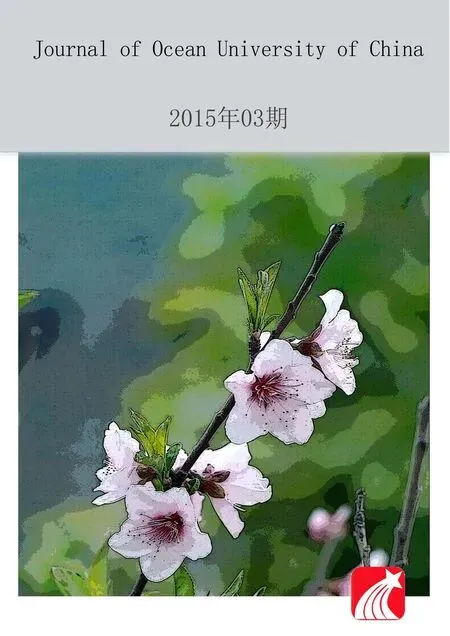 Journal of Ocean University of China2015年3期
Journal of Ocean University of China2015年3期
- Journal of Ocean University of China的其它文章
- Research on China’s Aquaculture Efficiency Evaluation and Influencing Factors with Undesirable Outputs
- Tolerance, Oxygen Consumption and Ammonia Excretion of Ophiopholis sarsii vadicola in Different Temperatures and Salinities
- Effect of Shrimp (Litopenaeus vannamei) Farming Waste on the Growth, Digestion, Ammonium-Nitrogen Excretion of Sea Cucumber (Stichopus monotuberculatus)
- Larval and Juvenile Growth Performance of Manila Clam Hybrids of Two Full-Sib Families
- Proline with or without Hydroxyproline Influences Collagen Concentration and Regulates Prolyl 4-Hydroxylase α (I) Gene Expression in Juvenile Turbot (Scophthalmus maximus L.)
- Cloning, Expression and Activity Analysis of a Novel Fibrinolytic Serine Protease from Arenicola cristata
